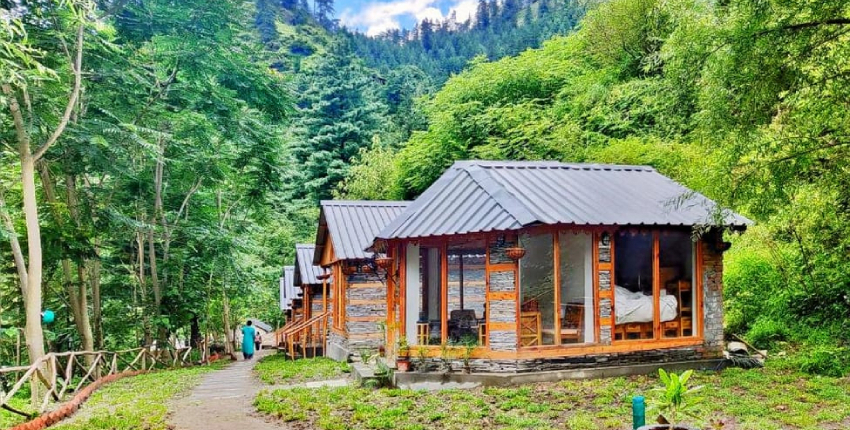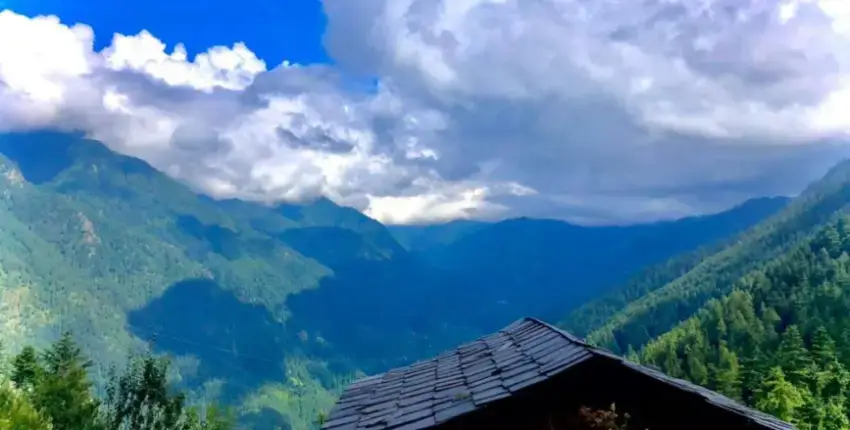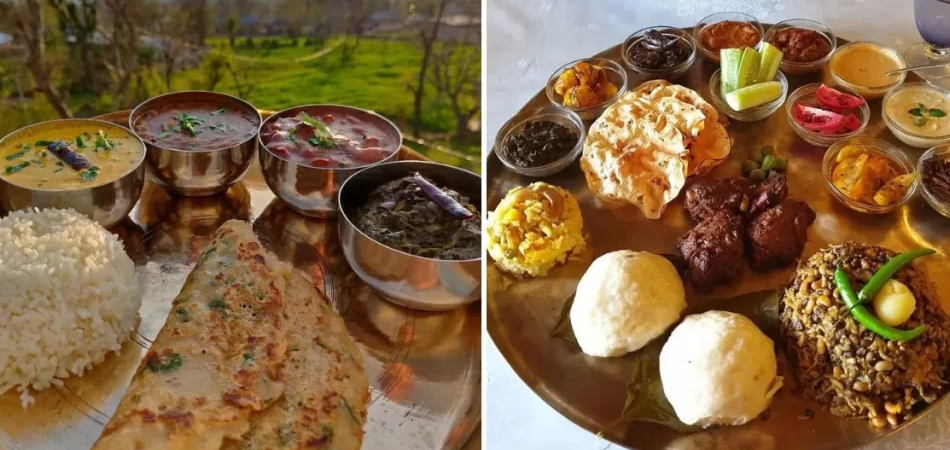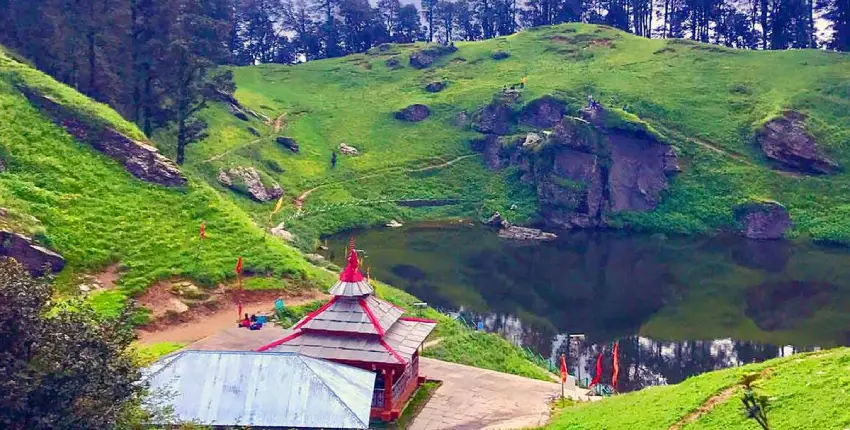
Jibhi is a offbeat hidden gem in the Tirthan Valley of Himachal Pradesh, where you can enjoy the beauty of nature and the culture of the locals. Jibhi is surrounded by lush green forests, serene waterfalls, and majestic mountains. You can visit Jibhi throughout the year, but the best time is from October to May when the weather is pleasant and the flowers are in bloom. Jibhi is a paradise for trekkers, as you can explore the nearby Jalori Pass, Serolsar Lake, Raghupur Fort, and more. You can also relax in a cozy homestay, visit the ancient Chaini Kothi, or meditate at the Shringa Rishi Temple. Jibhi is a perfect destination for a peaceful and memorable vacation.
Why Jibhi Stands Out

Jibhi is a slice of old-world Himachal. Its log huts, terraced fields, and misty mornings create a storybook setting. The valley is part of the Great Himalayan National Park (a UNESCO World Heritage Site), ensuring pristine landscapes and rich biodiversity.
Key Attractions in Jibhi
- Jalori Pass :
A high-altitude pass (3,120 m) offering panoramic views of the Dhauladhar and Pir Panjal ranges. It’s a quieter alternative to Rohtang, ideal for paragliding and snow play in winter. - Serolsar Lake :
A mystical alpine lake (3 km trek from Jibhi) surrounded by pine forests. Locals believe the lake is guarded by a deity—don’t miss the shrine dedicated to Bhairav nearby. - Raghupur Fort :
A 300-year-old fort ruin overlooking the valley, perfect for history buffs and photographers. - Jibhi Waterfalls :
Hidden cascades like the Bhudhi Nala and Tirthan River streams add charm to village walks. - Village Life :
Explore hamlets like Shoja and Gushaini , where you can stay in homestays, learn about trout fishing, or join apple harvests (Sept-Oct).
How to Reach Jibhi
- By Road :
- Nearest airport: Bhuntar (70 km).
- Drive from Delhi (≈9 hours) or Shimla (≈150 km).
- Regular buses ply from Mandi (≈70 km) to Banjar, followed by a 15 km taxi ride.
Where to Stay
- Log Huts : Opt for cozy stays like Jibhi Jungle Camp or Peaks & Pines for a rustic experience.
- Homestays : Stay with locals in Gushaini or Shoja for cultural immersion.
Best Time to Visit
- April–June : Mild weather, blooming rhododendrons, and clear treks.
- September–October : Autumn colors and crisp air.
- Winter (Dec–Feb) : Snow at Jalori Pass (carry chains for vehicles).
Unique Experiences
- Trekking : Hike to Thamsar Pass (5-day trek) or explore the Great Himalayan National Park .
- Camping : Pitch a tent by the Tirthan River for a night under the stars.
- Cultural Immersion : Learn about Gaddi tribal culture or try traditional Himachali dishes like siddu and madra .
What to Do in Jibhi

Jibhi has a lot to offer for adventurous and curious travelers. You can indulge in various activities and attractions that Jibhi has to offer, such as:
- Trekking around Jibhi: Jibhi is a base for many treks that lead to scenic places like Jalori Pass, Serolsar Lake, Raghupur Fort, Chehni Kothi, Shringa Rishi Temple, etc. You can enjoy the panoramic views of the Himalayas, the alpine meadows, the dense forests, and the sparkling lakes on these treks.
- Fishing in Tirthan : Jibhi is located on the banks of the Tirthan River, which is famous for its trout fish. You can try your luck at fishing in the river or take a guided fishing tour with an expert angler.
- Birdwatching at Tirthan: Jibhi is home to many exotic and rare birds like Himalayan griffon vulture, monal pheasant, koklass pheasant, etc. You can spot these birds in their natural habitat or take a guided birdwatching tour with a local guide.
- Photography in and around: Jibhi is a photographer’s delight as it offers many opportunities to capture the beauty of nature and culture in your lens. You can take pictures of the stunning landscapes, the charming villages, the colorful flowers, and the smiling faces of the locals.
- Sightseeing in Jibhi: Jibhi has many historical and religious places that you can visit and learn about their significance and stories. Some of these places are Chaini Kothi (an ancient tower house), Shringa Rishi Temple (a temple dedicated to the local deity), Jibhi Waterfall (a cascading waterfall), etc.
What to Eat in Jibhi – Food Options

Jibhi offers a variety of local cuisine and delicacies that you can savor and enjoy. Some of the dishes that you must try in Jibhi are:
- Siddu: This is a steamed bread stuffed with mashed potatoes, green peas, or walnuts. It is served with ghee, dal, or chutney.
- Trout Fish: This is a freshwater fish that is found in the Tirthan River. It is cooked in different ways, such as fried, grilled, or curry.
- Madra: This is a dish made of chickpeas or kidney beans cooked in yoghurt and spices. It is served with rice or roti.
- Chha Gosht: This is a dish made of lamb or goat meat cooked in yogurt, gram flour, and spices. It is served with rice or roti.
You can find these dishes in the local dhabas, homestays, or restaurants in Jibhi. Some of the best places to eat in Jibhi are:
- Tirthan Anglers’ Cafe: This is a cozy cafe that offers trout fish, siddur, pizza, pasta, and other dishes. You can also enjoy the river view and the music here.
- Jibhi Delight: This is a family-run restaurant that offers madra, chha gosht, rajma, and other dishes. You can also enjoy the homely atmosphere and the hospitality here.
- Shringi Vatika: This is a popular resort that offers a buffet of local and continental dishes. You can also enjoy the garden view and the bonfire here.
What to Pack for Jibhi

Jibhi is a place where you can experience different weather conditions depending on the season and altitude. Therefore, you need to pack accordingly for your trip to Jibhi. Some of the essential items that you need to pack for your trip to Jibhi are:
- Clothing: You need to pack warm clothes like sweaters, jackets, caps, gloves, etc. for the winter season (November to February) and light clothes like t-shirts, shorts, etc. for the summer season (March to June). You also need to pack raincoats or umbrellas for the monsoon season (July to September).
- Footwear: You need to pack sturdy shoes or boots for trekking and walking on uneven terrain. You also need to pack sandals or slippers for relaxing and sightseeing.
- Accessories: You need to pack sunglasses, hats, scarves, etc. for protection from the sun and the cold. You also need to pack torches, batteries, power banks, etc. for emergency situations.
- Toiletries: You need to pack basic toiletries like soap, shampoo, toothpaste, toothbrushes, etc. for your personal hygiene. You also need to pack sunscreen, moisturizer, lip balm, etc. for your skin care.
- Medicines: You need to pack some medicines like painkillers, antacids, antiseptics, bandages, etc. for minor ailments. You also need to pack some medicines like anti-allergens, anti-diarrheal, anti-nausea, etc. for travel sickness.
- Gadgets: You need to pack some gadgets like a camera, phone, laptop, etc. for capturing and sharing your memories. You also need to pack some gadgets like headphones, speakers, books, etc. for entertainment.
Final Thoughts
Jibhi Valley is a reminder of what Himachal once was—unspoiled, peaceful, and deeply connected to nature. Whether you’re sipping chai in a log hut or trekking to Serolsar Lake, Jibhi leaves you with stories to cherish.
Ready to explore Jibhi? Share your dream itinerary in the comments! 🌲✨
Offbeat And Lesser Known Places In Himachal Pradesh » HPTT By Planman's Group
[…] into the serene valley of Jibhi and journey through forests, discovering traditional wooden architecture and the unhurried local […]